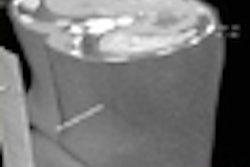Needle image plates provide higher image quality and allow for a 50% dose reduction in supine chest x-rays when compared with the conventional method, according to an article in press published in the European Journal of Radiology.
For chest radiographs in emergency departments, powder image plates (PIP) containing a layer of photostimulable crystals are often used, and they have almost replaced traditional film-screen systems. However, using different chemical substrates, the photostimulable crystals can be grown in a needle shape -- a needle image plate (NIP) -- that can be packed much closer than in PIP, resulting in higher quantum absorption and a smaller pixel size. The diagnostic value of conventional computed radiography (CR) is at least equivalent to traditional film-screen systems but the improved technology of NIP promises even better detail depiction, which Austrian researchers sought to assess.
Dr. Vanessa Berger-Kulemann from the department of radiology at the Medical University of Vienna and colleagues, compared the image quality of standard-dose CR with a PIP system to a dose-reduced needle technology CR for supine chest radiographs in a clinical setting and found higher image quality when using NIP as well as a dose reduction of 50% (Eur J Radiol, 27 July 2011).
In their prospective single-institution study, the researchers included a total of 32 consecutive immunocompromised intensive care patients. Each patient underwent allogenic hematopoietic stem cell transplantation and received multiple routine bedside chest x-rays on a mobile radiography unit (Mobilette, Siemens Healthcare). Routine images were obtained with a conventional system (ST-V, Fujifilm Medical Systems) using PIP. Needle-structured study images were obtained with the latest generation of detector plates (DX-S, Agfa HealthCare).
On the first day of the study, patients had a routine chest x-ray with the conventional PIP system and 100% of the exposure dose. Immediately after, the researchers obtained an additional chest x-ray with the NIP system and a lowered exposure dose of 50%. Three to four days after the first study, patients received a routine chest x-ray with the NIP system and the full exposure dose, and immediately after a chest x-ray with the PIP system at half the exposure dose.
Four images of each patient (PIP with full and half dose, NIP with full and half dose) were presented in a random order, side-by-side to two experienced radiologists, two residents in the third year of radiology training, and two clinicians (one specialist in cardiology and intensive care medicine and one pulmonary medicine subspecialist). They rated the following predetermined anatomical structures in each image:
- Four structures in low-absorption areas (central and peripheral vessels, lung parenchyma, pleural sinus)
- Three structures in high-absorption areas (carina and central bronchi, heart, and ribs)
The readers were also asked to assess the impression of image noise, the delineation of tubes and lines, and, if present, abnormalities. The readers then rated each on an image quality scale from 1 to 10 (1 = poor, 10 = excellent).
Overall rating scores were 5.9 for PIP with full dose, 5.7 for PIP with half dose, 7 for NIP with full dose, and 6.9 for NIP with half dose. A statistical difference (p < 0.05) was found for the two systems, as well as for the two dose levels. The readers significantly favored the NIP system at the same dose level.
The researchers also assessed central venous catheters. Overall rating scores were 6.6 for PIP with full dose, 6.4 for PIP with half dose, 7.5 for NIP with full dose, and 7.1 for NIP with half dose. As far as image noise, overall rating scores were 5.8 for PIP with full dose, 5.4 for PIP with half dose, 7.1 for NIP with full dose, and 6.8 for NIP with half dose.
|
"The results of this study show that the NIP system provided an excellent diagnostic performance in a clinical setting, and allows a reduction in the exposition dose of chest x-ray without loss of image quality," Berger-Kulemann wrote.
Anatomical structures such as lung parenchyma and the pulmonary vessels were rated superior in all images with the NIP system, compared with the PIP system, the authors wrote. The differences between the reader groups in rating anatomical structures, expressed as a rating of high and low absorption areas, were based on the subjective preference of the different readers in a side-by-side comparison.
"In any case, the results of our study showed consistency in favor of the NIP system in high and low absorption areas, compared to the PIP images for all readers, even if the reader group was intentionally heterogeneous, containing radiologists, and other specialty physicians," they wrote.
Physicians specializing in intensive care medicine, pulmonary diseases, and emergency medicine need to interpret chest x-rays in clinical practice, and many hospitals do not have a trained radiologist available, especially at night and on weekends, the authors wrote.
"A physician often initially interprets chest radiographs, and acute decisions are made on basis of the physicians' preliminary interpretation," they noted. "The final report should be performed by a radiologist. Nevertheless, the interpretation and subjective preference of nonradiological physicians is an important consideration in proving the superior image quality of the NIP system, particularly in dose-reduced radiographs."



















